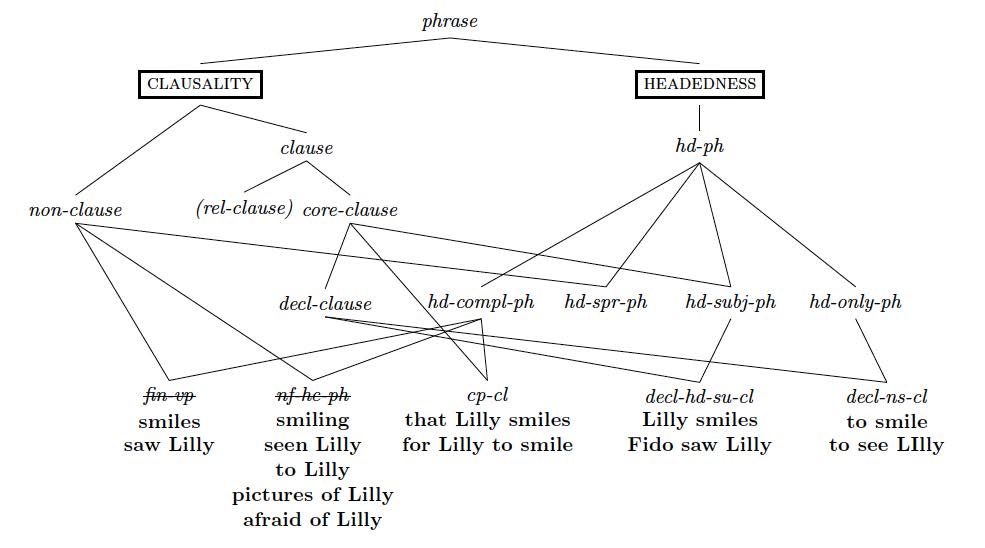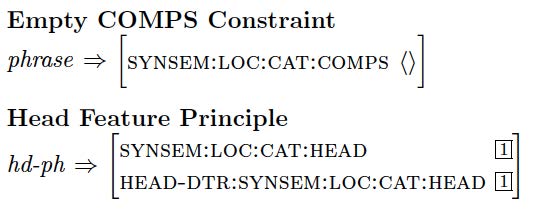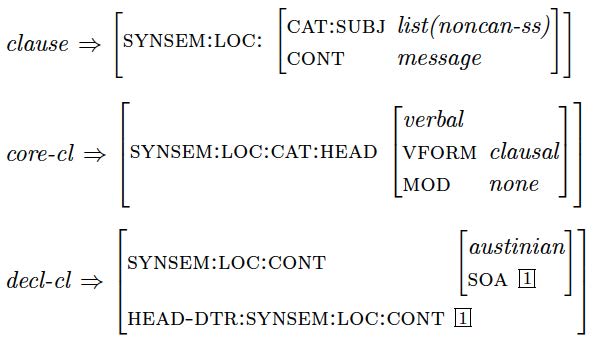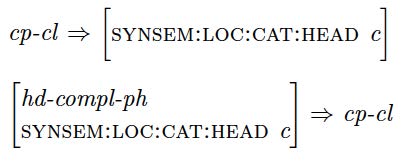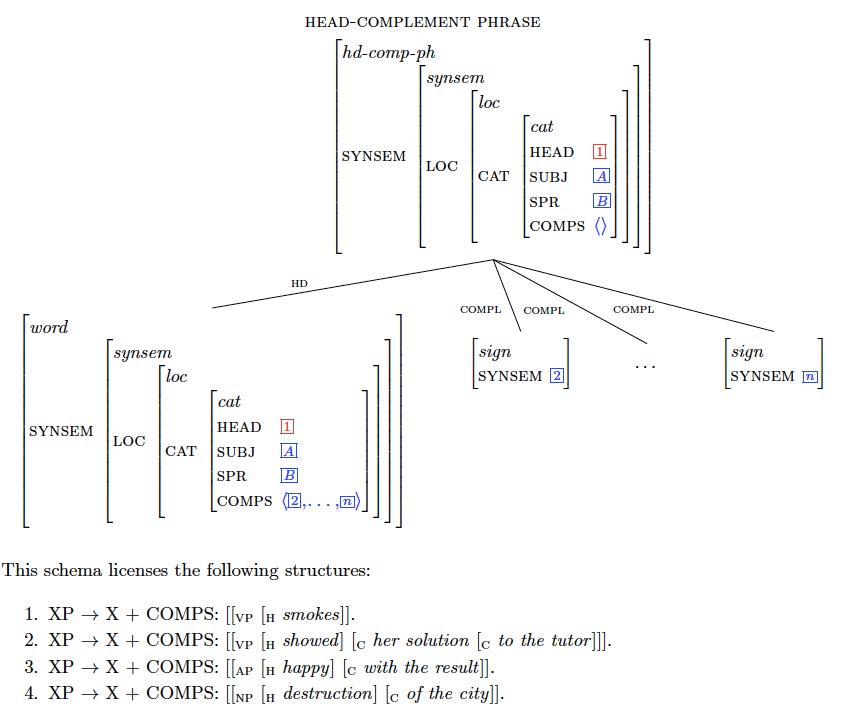Constraint-based Syntax 2: Week 5: Difference between revisions
| (21 intermediate revisions by the same user not shown) | |||
| Line 38: | Line 38: | ||
The second constraint permits infinitives which have not found their subject yet, i.e. infinitival VPs to act as clauses (cf. the concept of ''satzwertiger Infinitiv'' in traditional German grammar). | The second constraint permits infinitives which have not found their subject yet, i.e. infinitival VPs to act as clauses (cf. the concept of ''satzwertiger Infinitiv'' in traditional German grammar). | ||
== Constraints on | === Constraints on Verbs === | ||
The previous two phrase types we looked at, ''decl-hd-su-ph'' and ''decl-ns-ph'' are both required to be verbal. This is a good opportunity to look at some constraints of verbs. | |||
'''Exercise''' | |||
Below, four such constraints are stated in words. Using the same format of the constraints above, formalize each of the constraints. | |||
1. Subject-Verb Agreement | |||
''Finite verbs and their subjects share agreement features.'' | |||
Formally: | |||
<div class="toccolours mw-collapsible mw-collapsed" style="width:1000px"> | |||
Check your answer | |||
<div class="mw-collapsible-content"> | |||
[[File:Subject-verb-agreement-constraint.jpg]] | |||
</div> | |||
</div> | |||
2. Case | |||
''The subjects of finite verbs bear nominative case.'' | |||
Formally: | |||
<div class="toccolours mw-collapsible mw-collapsed" style="width:1000px"> | |||
Check your answer | |||
<div class="mw-collapsible-content"> | |||
[[File:Nominative_case_constraint.jpg]] | |||
</div> | |||
</div> | |||
3. Negation | |||
''Main verbs are never negated.'' | |||
Formally: | |||
<div class="toccolours mw-collapsible mw-collapsed" style="width:1000px"> | |||
Check your answer | |||
<div class="mw-collapsible-content"> | |||
[[File:Negation-constraint.jpg]] | |||
</div> | |||
</div> | |||
== Licensing Main Clauses == | |||
Now we have all the pieces in place to license whole main clauses like ''Fido visits her.'' We will work with the online grammar to see how this works. | |||
For convenience, open a second tab in your browser and copy the URL of the online grammar into its search field. When you have opened the grammar in the second tab, come back here! | |||
http://141.2.159.95:7002/wt/ | |||
We will look at the three words of the sentence one by one to understand what happens. | |||
1. '''The word''' ''Fido'':<br> | |||
Go to the grammar on the second tab and click on the lexical entry of ''Fido'' or type the word into '''Sentence''' box at the top left. You will see a little tree whose label N[''case'' ] means that ''Fido'' is a noun whose CASE value is compatible with any subtype of the type ''case''. Let us ignore the ":0" for now. | |||
If you now click on the top label, the full feature structure for the word opens. There is a lot of information, but let us concentrate on just the information in the path SYNSEM:LOC:CAT. We first find the head features, which tell us that the word's agreement value is ''third-person-singular''. We already know from the outside label that the word's CASE value is ''case''. The remaining head features are not relevant right now. | |||
Moving down, we see that the word ''Fido'' has a completely saturated valence: the value of each of the valence features is the empty list. That means that this word cannot be the head daughter of a ''hd-comp-ph'', a ''hd-spr-ph'', or a ''hd-subj-ph''; it can only act as a non-head daughter. | |||
2. '''The word''' ''her'':<br> | |||
Now parse the word ''her''. Its label shows us that this is a noun as well, but this time the noun's CASE is specific: it is ''nominative'', because the pronoun is lexically specified as having this case. If you click on the label and look at the word's CAT value, then you see that it also has ''third-person-singular" agreement and that its valence lists are all empty. | |||
3. '''The word''' ''visits'':<br> | |||
Finally, parse the word ''visits'' and look at its label: it tells you that the word is a finite verb. When you click on the label to see the full feature structure, the CAT value of the word is more interesting than in the previous two cases. The HEAD features tell you that the verb is ''finite'' and ''third-person-singular". Two of the three valence features are non-empty:<br> | |||
a. The SUBJ list contains one item whose label identifies it as a nominative NP (recall that the abbreviation ''NP'' stands for a feature structure (word or phrase) whose part of speech is ''noun'' and whose COMPS value is empty).<br> | |||
b. The COMPS list contains an accusative NP. | |||
Dont't look at the complete feature structures of the SUBj and the COMP synsems right now, since the information in the labels is all we need below. | |||
=== Building Phrases === | |||
We have two noun with empty COMPS lists and a finite verb that is looking for an accusative NP as its single complement. The only thing we can do at this point is to make a ''hd-comp-ph'' with the verb as head daughter and one of the two nouns as non-head-dtr. Since we aim to license the sentence ''Fido visits her.'' we choose ''her'' as the complement of ''like'' in the schema for Head-Complement Phrases: | |||
[[File:GS-hd-comp-ph.jpg]] | |||
Go to the second tab and parse the expression ''visits her''. Look at the result without clicking on anything. What do the labels on the nodes (before the colons) tell you? When you have studied the labels, leave the window open and come back here! | |||
The first important result of parsing ''visits her'' is that the grammar returns a tree. This means that it was able to combine the two words at the bottom. Unsurprisingly, the labels on the three nodes identify the expressions at the bottom as a finite verb and an accusative N(P). The mother's label identifies it as a finite VP. | |||
Now click on the labels of the VP and the verb and compare the CAT values of both. | |||
'''Exercise''' | |||
If the values for the VP and the V are the same, name the principle that enforces the identity! If they are different, name the principle that requires them to be different! | |||
Possible answers are, among others: because of the Head-Feature Principle, or because of the Empty COMPS Constraint, or because of the definition of ''hd-comp-ph''. | |||
One more important piece of information is found in the top left of the phrase's feature structure: the type of the feature structure identifies the expression as a ''hd-comp-ph. | |||
Now click on the label of the mother node to close the feature structure and open the feature structure of ''her'', so that you can see the feature structures of the verb and the noun next to each other. In the feature structure of ''her'', you see the two features SYNSEM and ARG-ST. We ignore ARG-ST for now and think about the SYNSEM information. After the feature name we find a boxed number 2. A boxed number means that there is some identity. In this case, the SYNSEM value of ''her'' is identified with something else in the tree. Can you see what it is? Can you explain which principle or schema creates that identification? What does the identification mean? | |||
=== Homework === | |||
Because of the very general definitions of the phrase types, most information in a phrasal node in one way or another is derived from information in the word that is the ultimate head of the phrase. Therefore, it is important to understand how words are structured internally. When you look at the details, you will see that almost every word belongs to some class of expressions which are structured in the same way, with each word contributing only a few pieces of word-specific information. | |||
In this homework you are supposed to convince yourself that the claim above is true for the following expression types in our online grammar: | |||
* Names | |||
* Pronouns | |||
* Intransitive verbs (only base forms) | |||
* Monotransitive verbs (only base forms) | |||
* Verbs of the ''put-class''. (only base forms) | |||
A simple way of seeing what, for instance, all names have in common is to proceed as follows: | |||
# In the online grammar, parse any name and open up the feature structure completely. | |||
# Take a screen shot of the feature structure and print it out. | |||
# Now parse a number of different names, open their feature structures completely, and find the places in the feature structure where the other names differ from the feature structure of your printout. | |||
# On your printout , draw a red square around the parts of the feature structure that may differ from name to name. | |||
# Voilá: all the parts of the feature structure on your printout which don't have a red square around them define the word group ''name'' in English. | |||
Now do the same for the other 4 word groups mentioned above and bring the printouts to class next time! | |||
| Line 55: | Line 183: | ||
Navigation: | Navigation: | ||
<div align="center"> | <div align="center"> | ||
[[Constraint-based_Syntax_2| '''Main page''']] [[Constraint-based_Syntax_2:_Week_1| '''Week 1''']] [[Constraint-based_Syntax_2:_Week_2| '''Week 2''']] [[Constraint-based_Syntax_2:_Week_3| '''Week 3''']] [[Constraint-based_Syntax_2:_Week_4| '''Week 4''']] Week5 | [[Constraint-based_Syntax_2| '''Main page''']] [[Constraint-based_Syntax_2:_Week_1| '''Week 1''']] [[Constraint-based_Syntax_2:_Week_2| '''Week 2''']] [[Constraint-based_Syntax_2:_Week_3| '''Week 3''']] [[Constraint-based_Syntax_2:_Week_4| '''Week 4''']] Week5 [[Constraint-based_Syntax_2:_Week_6| '''Week 6''']] Week7 Week8 Week9 Week10 | ||
</div> | </div> | ||
</font> | </font> | ||
Latest revision as of 08:54, 6 June 2017
A Simplified Type Hierarchy for Phrases
The type hierarchy for phrases of GS is fairly complex. In particular, Head-Complement Phrases are divided into the 2 subtypes fin-vp and nf-hc-ph. The motivation for this is that finite verb phrases in English have special properties with respect to negation and GS and Sag want to capture these properties in the definition of the type fin-vp. The disadvantage of this approach is that the second subtype of hd-comp-ph becomes cumbersome to state, since it includes phrases headed by non-finite verbs and phrases headed by nouns, adjectives, prepositions, and complementizers.
The online grammar avoids this complexity by eliminating the two types fin-vp and nf-hc-ph:
As a consequence, all the expressions which fell under one of these two types now simply have hd-compl-ph as their maximal phrase type.
Exercise
Go to the online grammar and type in expressions which you expect to be VPs (finite and non-finite), NPs, APs, and PPs. Click on the top node to convince yourself that all of these phrases belong to the type hd-compl-ph.
Type Constraints
The simplification of the phrase hierarchy requires some changes to the constraints associated with the types. But most constraints are actually unchanged. The Empty Comps Constraint and the Head-Feature Principle stay the same:
The constrains associated with most clause types also have not changed:
Complementizer clauses (that Lilly dances) require a change, though. They are the only hd-comp-ph which are clauses, since they have a message as their meaning. Therefore, we have to make sure that every complementizer clause actually belongs to the part of speech c. This is done in the first constraint below. Secondly, we must ensure that every hd-comp-ph" of part of speech c is actually a cp-cl, i.e. a complementizer clause:
Finally, there are constraints on the two subtypes of declarative clause in the online grammar. The first constraint says that Declarative Head-Subject Clauses must be finite.
The second constraint permits infinitives which have not found their subject yet, i.e. infinitival VPs to act as clauses (cf. the concept of satzwertiger Infinitiv in traditional German grammar).
Constraints on Verbs
The previous two phrase types we looked at, decl-hd-su-ph and decl-ns-ph are both required to be verbal. This is a good opportunity to look at some constraints of verbs.
Exercise
Below, four such constraints are stated in words. Using the same format of the constraints above, formalize each of the constraints.
1. Subject-Verb Agreement
Finite verbs and their subjects share agreement features.
Formally:
2. Case
The subjects of finite verbs bear nominative case.
Formally:
3. Negation
Main verbs are never negated.
Formally:
Licensing Main Clauses
Now we have all the pieces in place to license whole main clauses like Fido visits her. We will work with the online grammar to see how this works.
For convenience, open a second tab in your browser and copy the URL of the online grammar into its search field. When you have opened the grammar in the second tab, come back here!
We will look at the three words of the sentence one by one to understand what happens.
1. The word Fido:
Go to the grammar on the second tab and click on the lexical entry of Fido or type the word into Sentence box at the top left. You will see a little tree whose label N[case ] means that Fido is a noun whose CASE value is compatible with any subtype of the type case. Let us ignore the ":0" for now.
If you now click on the top label, the full feature structure for the word opens. There is a lot of information, but let us concentrate on just the information in the path SYNSEM:LOC:CAT. We first find the head features, which tell us that the word's agreement value is third-person-singular. We already know from the outside label that the word's CASE value is case. The remaining head features are not relevant right now.
Moving down, we see that the word Fido has a completely saturated valence: the value of each of the valence features is the empty list. That means that this word cannot be the head daughter of a hd-comp-ph, a hd-spr-ph, or a hd-subj-ph; it can only act as a non-head daughter.
2. The word her:
Now parse the word her. Its label shows us that this is a noun as well, but this time the noun's CASE is specific: it is nominative, because the pronoun is lexically specified as having this case. If you click on the label and look at the word's CAT value, then you see that it also has third-person-singular" agreement and that its valence lists are all empty.
3. The word visits:
Finally, parse the word visits and look at its label: it tells you that the word is a finite verb. When you click on the label to see the full feature structure, the CAT value of the word is more interesting than in the previous two cases. The HEAD features tell you that the verb is finite and third-person-singular". Two of the three valence features are non-empty:
a. The SUBJ list contains one item whose label identifies it as a nominative NP (recall that the abbreviation NP stands for a feature structure (word or phrase) whose part of speech is noun and whose COMPS value is empty).
b. The COMPS list contains an accusative NP.
Dont't look at the complete feature structures of the SUBj and the COMP synsems right now, since the information in the labels is all we need below.
Building Phrases
We have two noun with empty COMPS lists and a finite verb that is looking for an accusative NP as its single complement. The only thing we can do at this point is to make a hd-comp-ph with the verb as head daughter and one of the two nouns as non-head-dtr. Since we aim to license the sentence Fido visits her. we choose her as the complement of like in the schema for Head-Complement Phrases:
Go to the second tab and parse the expression visits her. Look at the result without clicking on anything. What do the labels on the nodes (before the colons) tell you? When you have studied the labels, leave the window open and come back here!
The first important result of parsing visits her is that the grammar returns a tree. This means that it was able to combine the two words at the bottom. Unsurprisingly, the labels on the three nodes identify the expressions at the bottom as a finite verb and an accusative N(P). The mother's label identifies it as a finite VP.
Now click on the labels of the VP and the verb and compare the CAT values of both.
Exercise
If the values for the VP and the V are the same, name the principle that enforces the identity! If they are different, name the principle that requires them to be different!
Possible answers are, among others: because of the Head-Feature Principle, or because of the Empty COMPS Constraint, or because of the definition of hd-comp-ph.
One more important piece of information is found in the top left of the phrase's feature structure: the type of the feature structure identifies the expression as a hd-comp-ph.
Now click on the label of the mother node to close the feature structure and open the feature structure of her, so that you can see the feature structures of the verb and the noun next to each other. In the feature structure of her, you see the two features SYNSEM and ARG-ST. We ignore ARG-ST for now and think about the SYNSEM information. After the feature name we find a boxed number 2. A boxed number means that there is some identity. In this case, the SYNSEM value of her is identified with something else in the tree. Can you see what it is? Can you explain which principle or schema creates that identification? What does the identification mean?
Homework
Because of the very general definitions of the phrase types, most information in a phrasal node in one way or another is derived from information in the word that is the ultimate head of the phrase. Therefore, it is important to understand how words are structured internally. When you look at the details, you will see that almost every word belongs to some class of expressions which are structured in the same way, with each word contributing only a few pieces of word-specific information.
In this homework you are supposed to convince yourself that the claim above is true for the following expression types in our online grammar:
- Names
- Pronouns
- Intransitive verbs (only base forms)
- Monotransitive verbs (only base forms)
- Verbs of the put-class. (only base forms)
A simple way of seeing what, for instance, all names have in common is to proceed as follows:
- In the online grammar, parse any name and open up the feature structure completely.
- Take a screen shot of the feature structure and print it out.
- Now parse a number of different names, open their feature structures completely, and find the places in the feature structure where the other names differ from the feature structure of your printout.
- On your printout , draw a red square around the parts of the feature structure that may differ from name to name.
- Voilá: all the parts of the feature structure on your printout which don't have a red square around them define the word group name in English.
Now do the same for the other 4 word groups mentioned above and bring the printouts to class next time!
Navigation:
